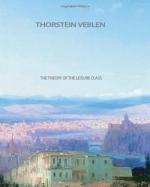
|
| Name: _________________________ | Period: ___________________ |
This test consists of 15 multiple choice questions and 5 short answer questions.
Multiple Choice Questions
1. Where did the earliest form of ownership take place?
(a) In lower barbarian stages of culture.
(b) In high industrial stages of culture.
(c) In early industrial stages of culture.
(d) In higher barbarian stages of culture.
2. What classes does Veblen describe emerging as society developed?
(a) Blue-collar and white-collar classes.
(b) Proletariat and bourgeoisie.
(c) Workers and parasites.
(d) Industrial and nonindustrial classes.
3. What term does Veblen use to describe horses and dogs?
(a) Conspicuous beauty.
(b) Pecuniary respectability.
(c) Pecuniary beauty.
(d) Conspicuous consumption.
4. What does Veblen say happens to cultures that develop knowledge and tools?
(a) They become more diplomatic.
(b) They become more decadent.
(c) They become more warlike.
(d) They become more efficient.
5. What does Veblen say an ownership society motivates people to do?
(a) Work hard.
(b) Conquer other people.
(c) Steal.
(d) Keep money within the family.
6. What standard does Veblen say guides people's behavior?
(a) The standard of the class just beyond their reach.
(b) The standard of the people surrounding them.
(c) The standard of the highest ranking relative in their ancestry.
(d) The standard of the class they were born into.
7. What does Veblen say happens as technology progresses?
(a) Men have more time for prayer.
(b) Men have more time for activities beyond subsistence.
(c) Men have more wives.
(d) Men have more children.
8. Who decides what level of consumption is honorable?
(a) The merchants.
(b) The community itself.
(c) The workers.
(d) The aristocrats.
9. Which cultures exhibited the leisure class?
(a) Primitive Indonesia.
(b) Postindustrial America.
(c) Feudal Europe.
(d) Migratory American Indians.
10. According to Veblen, property became a prerequisite for what?
(a) Respect.
(b) Starting a family.
(c) Reputation.
(d) Comfort.
11. What happens when people attain a certain level of consumption?
(a) It is easier to reach what has been just out of reach.
(b) It is difficult to move to a lower level.
(c) They try to raise their children with less frivolous things.
(d) They are free to move down, but it is difficult to move further up.
12. How do the clergy indicate the honor of their employment?
(a) By their devout productivity in the Church's work.
(b) By their dress and their nonproductive labor.
(c) By their conspicuous waste of productive land.
(d) By their meditation upon timeless concepts.
13. Where is conspicuous consumption most prevalent?
(a) In urban areas.
(b) In rural areas.
(c) In Paris.
(d) In court.
14. Who performs the most vicarious consumption, according to Veblen?
(a) Children.
(b) Servants.
(c) The wage earner.
(d) The women of the household.
15. What does Veblen say about the upper classes in Iceland and Polynesia?
(a) That they worked alongside the rest.
(b) That they offered their vassals' labor to the priests.
(c) That they invested the capital and give laborers the means of production.
(d) That they were barred from physical labor.
Short Answer Questions
1. What does consumption yield to the individual?
2. What factors drove the emergence of the leisure class?
3. What do expensive handmade clothes have that cheap imitations do not?
4. What happens to the standard of wealth over time?
5. What makes dress a good indicator of conspicuous waste?
|
This section contains 547 words (approx. 2 pages at 300 words per page) |

|




